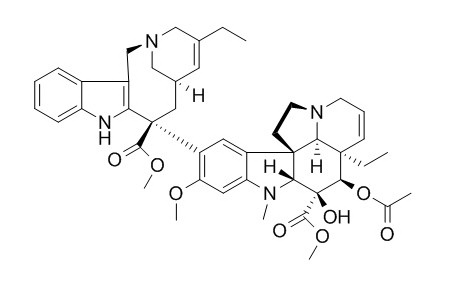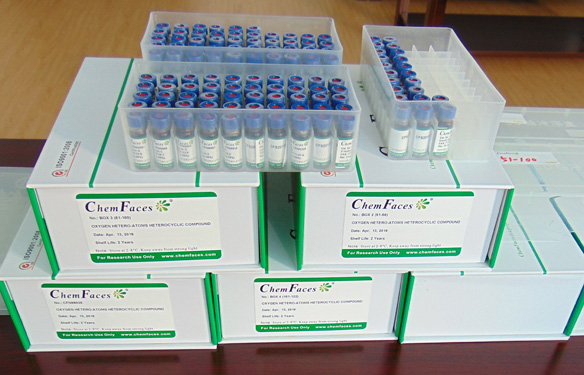Vinorelbine
Vinorelbine is a semi-synthetic Vinca alkaloid which is currently used in treatment of different cancer types mainly advanced breast cancer (ABC) and advanced/metastatic non-small cell lung cancer (NSCLC). Vinorelbine-loaded SSM can be developed as a new, safe, stable, and effective nanomedicine for the treatment of breast and lung cancers.
Inquire / Order:
manager@chemfaces.com
Technical Inquiries:
service@chemfaces.com
Tel:
+86-27-84237783
Fax:
+86-27-84254680
Address:
1 Building, No. 83, CheCheng Rd., Wuhan Economic and Technological Development Zone, Wuhan, Hubei 430056, PRC
Providing storage is as stated on the product vial and the vial is kept tightly sealed, the product can be stored for up to
24 months(2-8C).
Wherever possible, you should prepare and use solutions on the same day. However, if you need to make up stock solutions in advance, we recommend that you store the solution as aliquots in tightly sealed vials at -20C. Generally, these will be useable for up to two weeks. Before use, and prior to opening the vial we recommend that you allow your product to equilibrate to room temperature for at least 1 hour.
Need more advice on solubility, usage and handling? Please email to: service@chemfaces.com
The packaging of the product may have turned upside down during transportation, resulting in the natural compounds adhering to the neck or cap of the vial. take the vial out of its packaging and gently shake to let the compounds fall to the bottom of the vial. for liquid products, centrifuge at 200-500 RPM to gather the liquid at the bottom of the vial. try to avoid loss or contamination during handling.
Pharmaceuticals (Basel).2024, 17(10):1368.
Sains Malaysiana2022, 51(4):1143-1154
Preprints2022, 2022030063.
Life (Basel).2021, 11(12):1399.
Eur J Pharmacol.2021, 899:174010.
Int J Mol Sci.2019, 20(16):E4015
Industrial Crops and Products2022, 188:115638
Metabolites.2023, 13(6):689.
Nat Prod Sci.2019, 25(3):238
Talanta.2023, 262:124690.
Related and Featured Products
Lung Cancer. 2015 May;88(2):167-73.
Intravenous or oral administration of vinorelbine in adjuvant chemotherapy with cisplatin and vinorelbine for resected NSCLC.[Pubmed:
25769883 ]
Cisplatin and Vinorelbine given intravenously is a well-established adjuvant chemotherapy regimen after surgery for early-stage NSCLC. Vinorelbine can also be administered orally. However, the efficacy of orally administrated Vinorelbine in adjuvant treatment of NSCLC is unknown. We assessed the overall survival (OS) and disease-free survival (DFS) of patients treated with adjuvant i.v. Vinorelbine or p.o. Vinorelbine, in combination with i.v. cisplatin.
METHODS AND RESULTS:
We reviewed two time-separated cohorts of patients referred to the Department of Oncology at Aarhus University Hospital (Denmark) from 2005 to 2012 for adjuvant chemotherapy after surgery for NSCLC. RESULTS AND Of the 265 patients included in this study, 126 patients received i.v. and 139 received p.o. Vinorelbine/cisplatin. The two groups were comparable with respect to important baseline characteristics. Median OS for all patients was 78.7 months and the median DFS was 35.7 months. No statistically significant difference in OS or DFS for patients treated with i.v. or oral Vinorelbine was detected. The DFS rates of the two groups were comparable across all variables in subgroup analysis.
CONCLUSIONS:
In conclusion we observed that intravenous or oral administration of Vinorelbine in combination with cisplatin after surgery for NSCLC appear equally effective in terms of overall and disease-free survival.
Expert Opin Pharmacother. 2014 Aug;15(11):1585-99.
Oral vinorelbine in the treatment of non-small-cell lung cancer.[Pubmed:
24972635]
Originally formulated as an intravenous (i.v.) agent, Vinorelbine is also currently available as an oral chemotherapeutic agent.
METHODS AND RESULTS:
Oral Vinorelbine has demonstrated significant activity in different settings for NSCLC, including adjuvant treatment for resected disease, concurrent chemoradiation for locally advanced NSCLC and palliative chemotherapy for recurrent/metastatic NSCLC, as part of combination schedules or as a single-agent treatment. AREAS COVERED: The authors explored the available data describing the use of oral Vinorelbine in NSCLC. PubMed articles and abstracts presented at international conferences were analysed, and relevant trials were reported and discussed. Specific settings, including the treatment of elderly and unfit patients and metronomic schedules including oral Vinorelbine, were evaluated. Available pharmacoeconomic data were also assessed.
CONCLUSIONS:
Oral Vinorelbine is an appealing agent, particularly as part of combination regimens containing platinum derivatives, although it can have a role as a single-agent treatment as well. Its safety profile is generally favourable and its route of administration is generally preferred by patients receiving chemotherapy. Compared to i.v. Vinorelbine and other antineoplastic agents, oral Vinorelbine has been reported to be advantageous in terms of cost savings.
AAPS PharmSciTech. 2014 Oct;15(5):1138-48.
A new lipid-based nano formulation of vinorelbine.[Pubmed:
24871553]
Vinorelbine (VLB) is a semi-synthetic Vinca alkaloid which is currently used in treatment of different cancer types mainly advanced breast cancer (ABC) and advanced/metastatic non-small cell lung cancer (NSCLC). However, its marketed formulation has been reported to have serious side effects, such as granulocytopenia, which is the major dose-limiting toxicity. Other unwanted effects include venous discoloration and phlebitis proximal to the site of injection, as well as localized rashes and urticaria, blistering, and skin sloughing.
METHODS AND RESULTS:
Our long-term aim in synthesizing a novel nanomicellar Vinorelbine formulation is to reduce or even eliminate these side effects and increase drug activity by formulating the drug in a lipid-based system as a nanomedicine targeted to the site of action. To this end, the purpose of this study was to prepare, characterize, and determine the in vitro efficacy of Vinorelbine-loaded sterically stabilized, biocompatible, and biodegradable phospholipid nanomicelles (SSM; size, ∼15 nm). Our results indicated that Vinorelbine incorporate at high quantities and within the interface between the core and palisade sections of the micelles. Incorporation ratio of drug within sterically stabilized micelles increased as the total amount of drug in the system increased, and no drug particles were formed at the highest drug concentrations tested. The nanomicellar formulation of Vinorelbine was ∼6.7-fold more potent than Vinorelbine dissolved in DMSO on MCF-7 cell line.
CONCLUSIONS:
Collectively, these data indicate that Vinorelbine-loaded SSM can be developed as a new, safe, stable, and effective nanomedicine for the treatment of breast and lung cancers.



